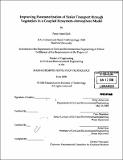| dc.contributor.advisor | Peter Shanahan and Rafael Bras. | en_US |
| dc.contributor.author | Link, Percy Anne | en_US |
| dc.contributor.other | Massachusetts Institute of Technology. Dept. of Civil and Environmental Engineering. | en_US |
| dc.date.accessioned | 2008-12-11T18:45:22Z | |
| dc.date.available | 2008-12-11T18:45:22Z | |
| dc.date.copyright | 2008 | en_US |
| dc.date.issued | 2008 | en_US |
| dc.identifier.uri | http://hdl.handle.net/1721.1/43884 | |
| dc.description | Thesis (M. Eng.)--Massachusetts Institute of Technology, Dept. of Civil and Environmental Engineering, 2008. | en_US |
| dc.description | Includes bibliographical references (p. 90-93). | en_US |
| dc.description.abstract | Several regional-scale ecosystem models currently parameterize subcanopy scalar transport using a rough-wall boundary eddy diffusivity formulation. This formulation predicts unreasonably high soil evaporation beneath tall, dense forests and low soil evaporation beneath short, sparse grass. This study investigates alternative formulations by reviewing literature on flow and scalar transport in canopies, taking field measurements of subcanopy latent heat flux, and testing alternative model formulations in constrained numerical experiments. A field campaign was conducted in a dense rainforest in Luquillo National Forest, Puerto Rico, to measure wind and fluxes with eddy covariance devices. Wind velocities and fluxes of latent heat, sensible heat, and momentum were found to be much smaller below the canopy than above it. Modeling experiments tested a mixing-layer-based formulation of eddy diffusivity and a soil evaporation cutoff based on vortex penetration depth. The vortex penetration cutoff was found to be the most physically accurate and computationally simple option, and this study recommends that ecosystem and land-surface models adopt this formulation for subcanopy scalar transport. | en_US |
| dc.description.statementofresponsibility | by Percy Anne Link. | en_US |
| dc.format.extent | 123 p. | en_US |
| dc.language.iso | eng | en_US |
| dc.publisher | Massachusetts Institute of Technology | en_US |
| dc.rights | M.I.T. theses are protected by
copyright. They may be viewed from this source for any purpose, but
reproduction or distribution in any format is prohibited without written
permission. See provided URL for inquiries about permission. | en_US |
| dc.rights.uri | http://dspace.mit.edu/handle/1721.1/7582 | en_US |
| dc.subject | Civil and Environmental Engineering. | en_US |
| dc.title | Improving parameterization of scalar transport through vegetation in a coupled ecosystem-atmosphere model | en_US |
| dc.type | Thesis | en_US |
| dc.description.degree | M.Eng. | en_US |
| dc.contributor.department | Massachusetts Institute of Technology. Department of Civil and Environmental Engineering | |
| dc.identifier.oclc | 263684584 | en_US |
